
- Poems Poetry Art
- Author
- Alfred French (11)
- Charles Bukowski (12)
- Clarence F Underwood (6)
- Edgar Allan Poe (16)
- Edmund Spenser (7)
- Eyvind Earle (15)
- Jack Hirschman (16)
- John Hejduk (9)
- John Milton (7)
- Lance Woolaver (7)
- Lindley Murray (8)
- Patti Smith (16)
- Reilly Rhodes (11)
- Rosaleen Norton (6)
- Shel Silverstein (9)
- Unknown (9)
- Various (40)
- William Blake (9)
- William Shakespeare (7)
- Wulf Segebrecht (17)
- ... (3209)
- Binding
- Language
- Arabic (3)
- Czech & English (11)
- Dutch (5)
- Eng, Gec (3)
- English (1340)
- English, Japanese (3)
- English, Persian (3)
- English, Russian (9)
- French (43)
- Germ, German (4)
- German (45)
- German, Germ (12)
- Hebrew (3)
- Italian (11)
- Japanese (18)
- Latin (11)
- Persian (7)
- Portuguese (3)
- Russian (19)
- Spanish (13)
- ... (1881)
- Publisher
- Abrams, Inc. (12)
- Bernard Lintott (6)
- Brill (6)
- Broadside Press (10)
- De Selliers, Diane (10)
- E. Little & Co (8)
- George Olms (16)
- Gotham Press (9)
- Hard Press (15)
- Harpercollins (7)
- J.b. Metzlersche (17)
- Museum Of Modern Art (9)
- Nimbus Publishing (7)
- Rizzoli (9)
- Samuel French (7)
- Sore Dover Press (7)
- Ten Crow Press (6)
- Thames & Hudson (6)
- Unknown (11)
- X-ray Book Company (6)
- ... (3263)
- Region
- Signed
Original Signed HAKU MAKI Modern Japanese Mixed Media Print POEM'69-45 MCM
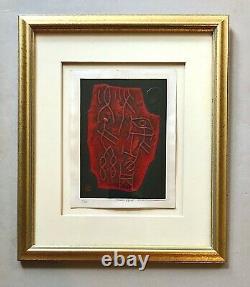
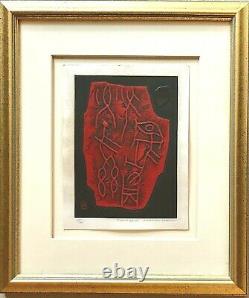


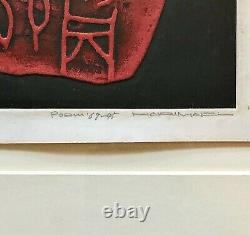
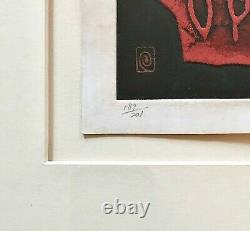
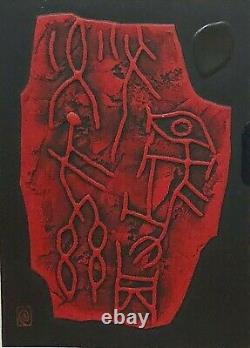
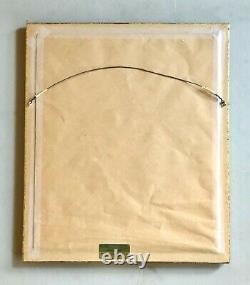


Artist: Maki Haku (Japan, 1924 - 2000). Mixed media with intaglio and embossing. Signed: Signed in pencil below the image l. In western script, and chop-signed in the print. Additionally editioned in pencil, l.
8-3/4 x 6-3/4 inches on thick paper. Matted within quality gilt wood frame measuring 15-1/2 x 13 inches. Condition: Not examined out of frame but a strong impression in very good condition; some discoloration to matt, backing sheet taped in place. Maki Hakus works abstract individual kanji characters sometimes to a point of unrecognizability, homing in on their artistic forms. His works are deeply embossed to make prominent the sculptural and three-dimensional quality of prints.Maki also highlighted the unique textures of the concrete or the grain of the wood on which he made his prints. As artists of the ssaku-hanga movement broke away from traditional Japanese printmaking practices to instead embrace a spirit of individuality and experimentation, drawing aesthetic influence from the West, the prints included in this selection show how some artists sought to balance the tensions between individualism and nationalism, traditional and modern, Japan and the West through the exploration of distinctly Japanese subject matter. Maki Haku (, 19242000) is the artistic name of Maejima Tadaaki, who was born in Ibaraki Prefecture. He was a ssaku-hanga artist in 20th Century Japan.
During World War II, Maejima Tadaaki was trained as a kamikaze pilot in the Japanese air force, but the war ended before he was assigned a mission. Haku had no formal art training, but studied for two years with the ssaku-hanga artist Onchi Kshir (18911955). Two unique qualities of Maki Haku prints are the textures achieved by working the designs in wet cement and the use of Kanji (Chinese characters) as design motifs.In 1962, he started adding texture to his prints. At first, he added texture to the entire sheet after it was printed.
In 1965, he began embossing designs into unprinted paper by using a press to transfer a design created in cement on a carved plywood board, and then adding color with stencils. He distorted and rearranged the strokes of Chinese characters to produce striking and serene images. For example, Poem 71-91 is a highly stylized representation of the kanji , which is pronounced mu and means nothingness, an important concept in some forms of Buddhism.
Haku participated in the Tokyo International Print Biennale in 1957 and 1960. The book Festive Wine: Ancient Japanese Poems from the Kinkafu is a translation of 21 ancient poems called Kinkafu or Music for Wagon Songs. The translation is accompanied by Maki Haku's prints that were made in 196869.
The Art Institute of Chicago, the Cincinnati Art Museum, the Honolulu Museum of Art, the Los Angeles County Museum of Art, the Museum of Fine Arts, Boston, the Museum of Modern Art (New York), the University of Michigan Museum of Art, and the Philadelphia Museum of Art are among the public collections holding prints by Maki Haku. These charges are the buyers responsibility.The item "Original Signed HAKU MAKI Modern Japanese Mixed Media Print POEM'69-45 MCM" is in sale since Tuesday, December 14, 2021. This item is in the category "Art\Art Prints". The seller is "sturmgeo" and is located in Silver Spring, Maryland.
This item can be shipped worldwide.- Size: Small (up to 12in.)
- Region of Origin: Japan
- Title: Collection-58
- Type: Print
- Signed: Yes
- Signed By: HAKU MAKI
- Original/Licensed Reprint: Original
- Handmade: Yes
- Artist: Haku Maki
- Production Technique: Intaglio, embossing
- Framing: Matted & Framed
- Country/Region of Manufacture: Japan
- Style: Asian Modernism
- Material: Paper
- Features: Embossed
- Subject: Asian
- Listed By: Dealer or Reseller
- Year of Production: 1960s
- Date of Creation: 1960's
- Original/Reproduction: Original Print
- Width (Inches): 6.75"
- Height (Inches): 8.75"
- Print Surface: Paper

